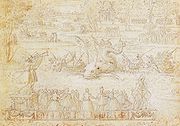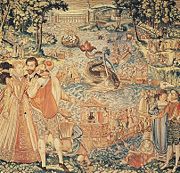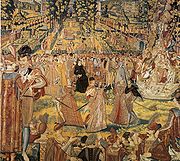
Valois Tapestries
Encyclopedia

Tapestry
Tapestry is a form of textile art, traditionally woven on a vertical loom, however it can also be woven on a floor loom as well. It is composed of two sets of interlaced threads, those running parallel to the length and those parallel to the width ; the warp threads are set up under tension on a...
depicting festivities or "magnificences" at the Court of France
France
The French Republic , The French Republic , The French Republic , (commonly known as France , is a unitary semi-presidential republic in Western Europe with several overseas territories and islands located on other continents and in the Indian, Pacific, and Atlantic oceans. Metropolitan France...
in the second half of the 16th century. The tapestries were worked in the Spanish Netherlands, probably in Brussels or Antwerp, shortly after 1580.
Scholars have not firmly established who commissioned the tapestries or for whom they were intended. It is likely that they were once owned by Catherine de' Medici
Catherine de' Medici
Catherine de' Medici was an Italian noblewoman who was Queen consort of France from 1547 until 1559, as the wife of King Henry II of France....
, but they are not included in the inventory of possessions drawn up after her death. She had probably presented them to her granddaughter Christina of Lorraine
Christina, Grand Duchess of Tuscany
Christina of Lorraine or Chretienne de Lorraine was a member of the House of Lorraine and was the Grand Duchess of Tuscany by marriage...
, for her marriage
Intermedio
The intermedio, or intermezzo, in the Italian Renaissance, was a theatrical performance or spectacle with music and often dance which was performed between the acts of a play to celebrate special occasions in Italian courts. It was one of the important predecessors to opera, and an influence on...
to Ferdinando I de' Medici, Grand Duke of Tuscany
Ferdinando I de' Medici, Grand Duke of Tuscany
Ferdinando I de' Medici, Grand Duke of Tuscany was Grand Duke of Tuscany from 1587 to 1609, having succeeded his older brother Francesco I.-Biography:...
, in 1589. The tapestries are now stored at the Uffizi Gallery in Florence, Tuscany, but are not on public display.
Composition and context

Antoine Caron
Antoine Caron was a French master glassmaker, illustrator, Northern Mannerist painter and a product of the School of Fontainebleau.He is one of the few French painters of his time who had a pronounced artistic personality...
during the reign of King Charles IX of France
Charles IX of France
Charles IX was King of France, ruling from 1560 until his death. His reign was dominated by the Wars of Religion. He is best known as king at the time of the St. Bartholomew's Day Massacre.-Childhood:...
(1560–1574). These were modified by a second artist, who reveals a strong personality of his own, to include groups of full-length figures in the foreground. Historian Frances Yates
Frances Yates
Dame Frances Amelia Yates DBE was a British historian. She taught at the Warburg Institute of the University of London for many years.She wrote extensively on the occult or Neoplatonic philosophies of the Renaissance...
believed that this second artist was the influential Lucas de Heere
Lucas de Heere
Lucas de Heere was a Flemish portrait painter, poet and writer.De Heere was a Protestant and became a refugee from the Dutch Revolt against Philip II of Spain, who tried to suppress Protestantism...
.
The Protestant de Heere, who died in 1584, had previously designed tapestries for Catherine de' Medici in France. In his last years, he was working in Flanders for William the Silent
William the Silent
William I, Prince of Orange , also widely known as William the Silent , or simply William of Orange , was the main leader of the Dutch revolt against the Spanish that set off the Eighty Years' War and resulted in the formal independence of the United Provinces in 1648. He was born in the House of...
, the founder of the House of Orange-Nassau
House of Orange-Nassau
The House of Orange-Nassau , a branch of the European House of Nassau, has played a central role in the political life of the Netherlands — and at times in Europe — since William I of Orange organized the Dutch revolt against Spanish rule, which after the Eighty Years' War...
and the ally of Catherine de' Medici's youngest son François, Duke of Anjou
François, Duke of Anjou
Francis, Duke of Anjou and Alençon was the youngest son of Henry II of France and Catherine de' Medici.-Early years:...
. In 1582, de Heere designed the decorations for Anjou's Joyous Entry
Joyous Entry
A Joyous Entry was a local name used for the royal entry - the first official peaceable visit of a reigning monarch, prince, duke or governor into a city - mainly in the Duchy of Brabant or the County of Flanders and occasionally in France, Luxembourg or Hungary, often coinciding with...
into Ghent
Ghent
Ghent is a city and a municipality located in the Flemish region of Belgium. It is the capital and biggest city of the East Flanders province. The city started as a settlement at the confluence of the Rivers Scheldt and Lys and in the Middle Ages became one of the largest and richest cities of...
, de Heere's home town. Between 1582, when Anjou was installed as the duke of Brabant
Duke of Brabant
The Duchy of Brabant was formally erected in 1183/1184. The title "Duke of Brabant" was created by the German Emperor Frederick Barbarossa in favor of Henry I, son of Godfrey III of Leuven . The Duchy of Brabant was a feudal elevation of the since 1085/1086 existing title of Landgrave of Brabant...
, and his death in 1584, when he still held the town of Cambrai
Cambrai
Cambrai is a commune in the Nord department in northern France. It is a sub-prefecture of the department.Cambrai is the seat of an archdiocese whose jurisdiction was immense during the Middle Ages. The territory of the Bishopric of Cambrai, roughly coinciding with the shire of Brabant, included...
, the French prince opposed the forces of Alexander Farnese, Duke of Parma
Alexander Farnese, Duke of Parma
Alexander Farnese was Duke of Parma and Piacenza from 1586 to 1592, and Governor of the Spanish Netherlands from 1578 to 1592.-Biography:...
, governor of the Spanish Netherlands. He met with little success, however, owing to a desperate shortage of funds to pay his troops. Art historian Roy Strong
Roy Strong
Sir Roy Colin Strong FRSL is an English art historian, museum curator, writer, broadcaster and landscape designer. He has been director of both the National Portrait Gallery and the Victoria and Albert Museum in London...
has questioned Yates's finding that the tapestries were produced in Antwerp under Lucas de Heere, suggesting that they contain Brussels markings.

Huguenot
The Huguenots were members of the Protestant Reformed Church of France during the 16th and 17th centuries. Since the 17th century, people who formerly would have been called Huguenots have instead simply been called French Protestants, a title suggested by their German co-religionists, the...
, cause." They argue that the Huguenots are depicted in the tapestries not, as Yates believed, to demonstrate the tolerance of the Valois and offer a vision of different faiths and peoples at peace, but to illustrate the certain defeat of the Protestants at the hands of the Valois. They interpret the inclusion of Turks alongside the Huguenots to indicate that both were regarded as "infidels", an association previously made in the Tunis tapestries for the Habsburg Philip II's
Philip II of Spain
Philip II was King of Spain, Portugal, Naples, Sicily, and, while married to Mary I, King of England and Ireland. He was lord of the Seventeen Provinces from 1556 until 1581, holding various titles for the individual territories such as duke or count....
marriage to Mary I of England
Mary I of England
Mary I was queen regnant of England and Ireland from July 1553 until her death.She was the only surviving child born of the ill-fated marriage of Henry VIII and his first wife Catherine of Aragon. Her younger half-brother, Edward VI, succeeded Henry in 1547...
.
Jardine and Brotton also suggest that the Valois tapestries have a clear antecedent in the triumphalist History of Scipio tapestries designed for Francis I
Francis I of France
Francis I was King of France from 1515 until his death. During his reign, huge cultural changes took place in France and he has been called France's original Renaissance monarch...
by Giulio Romano
Giulio Romano
Giulio Romano was an Italian painter and architect. A pupil of Raphael, his stylistic deviations from high Renaissance classicism help define the 16th-century style known as Mannerism...
. Yates believed that the depiction of an elephant in one of the tapestries was based on engravings of Anjou's staged entry
Royal Entry
The Royal Entry, also known by various other names, including Triumphal Entry and Joyous Entry, embraced the ceremonial and festivities accompanying a formal entry by a ruler or his representative into a city in the Middle Ages and Early Modern Period in Europe...
into Antwerp. Jardine and Brotton suggest instead that Antoine Caron based his designs for the Elephant tapestry on his own painting Night Festival with an Elephant, which in turn draws on The Battle of Zama from the Scipio tapestries. They also maintain that the political message of those tapestries remained part of the Valois ethos, since the Triumph of Scipio was displayed during the summit meeting between the French and Spanish courts at Bayonne. Knecht urges caution, however. The obvious intent of the tapestries is to glorify the house of Valois; beyond that, he believes, all is speculation.
The fêtes

Catherine de' Medici's court festivals
Catherine de' Medici's court festivals were a series of lavish and spectacular entertainments, sometimes called "magnificences", laid on by Catherine de' Medici, the queen consort of France from 1547 to 1559 and queen mother from 1559 until her death in 1589...
. Some of the entertainments recorded in the tapestries can be identified with known events, such as the festivals mounted at Fontainebleau
Château de Fontainebleau
The Palace of Fontainebleau, located 55 kilometres from the centre of Paris, is one of the largest French royal châteaux. The palace as it is today is the work of many French monarchs, building on an early 16th century structure of Francis I. The building is arranged around a series of courtyards...
and at Bayonne
Bayonne
Bayonne is a city and commune in south-western France at the confluence of the Nive and Adour rivers, in the Pyrénées-Atlantiques department, of which it is a sub-prefecture...
during Charles IX's
Charles IX of France
Charles IX was King of France, ruling from 1560 until his death. His reign was dominated by the Wars of Religion. He is best known as king at the time of the St. Bartholomew's Day Massacre.-Childhood:...
royal progress of 1564–65; and the ball held for the Polish ambassadors at the Tuileries
Tuileries Palace
The Tuileries Palace was a royal palace in Paris which stood on the right bank of the River Seine until 1871, when it was destroyed in the upheaval during the suppression of the Paris Commune...
in 1573. Particularly lavish were the tournaments
Tournament (medieval)
A tournament, or tourney is the name popularly given to chivalrous competitions or mock fights of the Middle Ages and Renaissance . It is one of various types of hastiludes....
and fêtes held in 1565 in Bayonne
Bayonne
Bayonne is a city and commune in south-western France at the confluence of the Nive and Adour rivers, in the Pyrénées-Atlantiques department, of which it is a sub-prefecture...
, near the Spanish border of France, where Catherine met with her daughter Elisabeth, Queen of Spain
Elisabeth of Valois
Elisabeth of Valois was the eldest daughter of Henry II of France and Catherine de' Medici.-Early life:She was born in the Château de Fontainebleau...
, amidst rituals of display from both courts. The latest event identifiable in the tapestries was held in 1573 at the Tuileries, where Catherine laid on a ball for ambassadors from the Polish governing council, who had elected her son Henry as king of Poland. The costumes worn by the courtiers in the tapestries have been dated to not later than c. 1580.
For Catherine de' Medici, who masterminded these occasions and may have ordered the tapestries that commemorated them, such entertainments were worth their colossal expense, since they served a political purpose. Presiding over the royal government at a time when the French monarchy was in steep decline, she set out to show not only the French people but foreign courts that the Valois monarchy was as prestigious and magnificent as it had been during the reigns of Francis I
Francis I of France
Francis I was King of France from 1515 until his death. During his reign, huge cultural changes took place in France and he has been called France's original Renaissance monarch...
and her husband Henry II
Henry II of France
Henry II was King of France from 31 March 1547 until his death in 1559.-Early years:Henry was born in the royal Château de Saint-Germain-en-Laye, near Paris, the son of Francis I and Claude, Duchess of Brittany .His father was captured at the Battle of Pavia in 1525 by his sworn enemy,...
.

People in the tapestries
Most of the full-length figures in the foreground of the tapestries are recognisable as members of the French royal family and court. François, duke of Anjou, is featured prominently in some of the tapestries; and Catherine de' Medici, dressed in her widow's black, occupies the central position in all of the tapestries except one. Catherine's daughter Marguerite de ValoisMarguerite
Marguerite is the French form of a female given name which derives from the Greek Μαργαρίτης meaning "pearl")...
can also be seen.
One absentee from the tapestries is King Charles IX of France
Charles IX of France
Charles IX was King of France, ruling from 1560 until his death. His reign was dominated by the Wars of Religion. He is best known as king at the time of the St. Bartholomew's Day Massacre.-Childhood:...
, who was on the throne at the time of the events depicted, but who had died (1574) by the time the hangings were woven. Yates speculates that the Protestant creators of the tapestries deliberately cut him out because of his involvement in the St. Bartholomew's Day massacre
St. Bartholomew's Day massacre
The St. Bartholomew's Day massacre in 1572 was a targeted group of assassinations, followed by a wave of Roman Catholic mob violence, both directed against the Huguenots , during the French Wars of Religion...
of 1572, in which thousands of French Protestants, or Huguenots, were slaughtered on his orders. Antoine Caron
Antoine Caron
Antoine Caron was a French master glassmaker, illustrator, Northern Mannerist painter and a product of the School of Fontainebleau.He is one of the few French painters of his time who had a pronounced artistic personality...
's original drawings for the tapestries, of which six survive, show Charles taking part in the festivities. It is the later artist who removes Charles from the designs and adds the figures in the foreground who relate to the court of Charles's successor Henry III.

